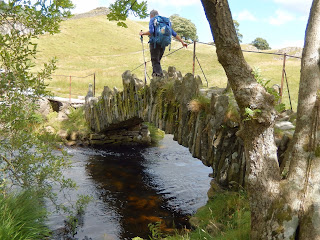July 15: Rain and low clouds today so we opted for a bus ride to Coniston and a look around. We first stopped at the parish church to John Ruskin's grave before heading to the lakeside of Coniston Water. We walked under our umbrellas the whole time. Yesterday's sunshine disappeared so quickly, we might have imagined it.
 |
| Coniston Parish Church with unique roof trusses |
 |
| John Ruskin's gravestone |
After the lake front, where we saw the gas powered "gondola" that gives tourist rides on the lake (not much activity today), some restaurants/ice cream shops and a flock of ducks begging for food, we decided to walk to Brantwood, the last home of John Ruskin. It is was located across the lake and about 2.5 miles away. We walked with umbrellas, partially on public footpaths and partly on a narrow, little used road.
 |
| A powered 'Gondola' |
Arriving at Brantwood, we went in, learned about John Ruskin by watching a 15-minute video, and then toured his home from the 1870's until his death in 1900. He was a man ahead of his time, and because of this, was probably not accepted by the establishment. He first made a name for himself as an ardent supporter of the paintings of J.M. Turner and thus became a leading art critic of his time. He could draw and paint also but rarely for sale. He was an avid collector of seashells and rocks/minerals, and as an only son in a higher class family from London, traveled in Europe often. He became a social critic and railed against the ravages caused by capitalism - poverty, child labor, environmental degradation, etc. He supported the creation of a minimum wage, reasonable working hours, and the like, none of which were adopted before his death. He was also influential in establishing the National Trust (England's public organization which preserves natural and cultural heritages), protecting scenic areas like the Lake District, and supporting the idea of a common economic union in Europe. This last one got a chuckle from others in the audience.
The house was interesting and beautiful, although the areas open to the public are limited. We toured a great study - very inviting and comfortable with wallpaper of Ruskin's own design - and three other larger and more formal rooms (drawing room, dining room and sitting room).
Upstairs we saw his bedroom, recreated with his favorite paintings by Turner and others which covered most of the wall space. A small turret constructed in one corner afforded the views across Coniston Water to Old Man of Coniston and other fells shared by the other west-facing rooms. With a cozy chair and a tea table, one could sit there for hours enjoying the scenery. There was also a small studio upstairs, which was more like a store room of his collectibles.
We could have toured the vast gardens, English-style I think, but we were already wet enough and it was still raining.
 |
| Brantwood, the turret is to the left, second floor |
 |
| The view from Brantwood to Coniston, on a not particularly good weather day |
We stopped for tea and ginger bread at the connected cafe, before walking back to the catch a bus home. We walked back along the road, periodically hopping to the edge to avoid the cars that come racing at you on what is a one lane wide road. Driving here is not for the faint of heart.
July 16: Today, the weather cleared, as you will see from the photos, and we took the bus to Dungeon Ghyll for an 8-mile walk around Lingmoor Fell. We walked first up, over and down on the higher, western side of the fell in a valley between Lingmoor and Wrynose Fell past Side Pike, Blea Tarn and Blea Moss. A pike is a peak, a tarn is a small lake, and a moss is a fen or wetland or bog. We joined an historic route that goes west over Wrynose Pass and goes east to Ambleside. It has been in use for over 2,000 years, linking Roman forts at Ravenglass, Hardknott and Ambleside and later used by packhorse trains. While in the higher countryside, we had great views back to Langdale Pikes, Bow Fell, our route up to Stake Pass (which we walked a week ago), and Crinkle Crags.
 |
| Bow Fell and to the right the route up to Stake Pass |
 |
| Langdale Pikes (Pike of Stickle, Loft Crag, Harrison Stickle and Pavey Ark) |
We had damp feet after crossing the Blea Moss but went quickly down to the Little Langdale Valley, with its tarn of the same name. We passed Ting Mound, which was a historic meeting spot established in the 7th century. People would come together at this outdoor space to conduct local administration and to hold courts. It was a convenient spot along the historic 'trade' route.
 |
| Some type of orchid (?) |
 |
| Blea Tarn |
We crossed over a small, interesting, handcrafted bridge, known as Slaters Bridge, thought to have been built by nearby quarry workers, presumably known as 'slaters.' The quarries produced slate and are now 'disused.' It's a very scenic spot and families were enjoying picnics and playing in the water.
 |
| Slaters Bridge |
We crossed out the Little Langdale Valley and descended into the Great Langdale Valley and sped quickly through the flat lowlands back to Dungeon Ghyll. We crossed the Great Langdale Beck, which is a good sized river at this point. We caught the bus back to Ambleside, using the last day of our 7-day pass we bought last Sunday.
We had dinner in. Betsy made chicken with tomato sauce, which we had over pasta, and a salad.














No comments:
Post a Comment
Let us know if you are enjoying the news: